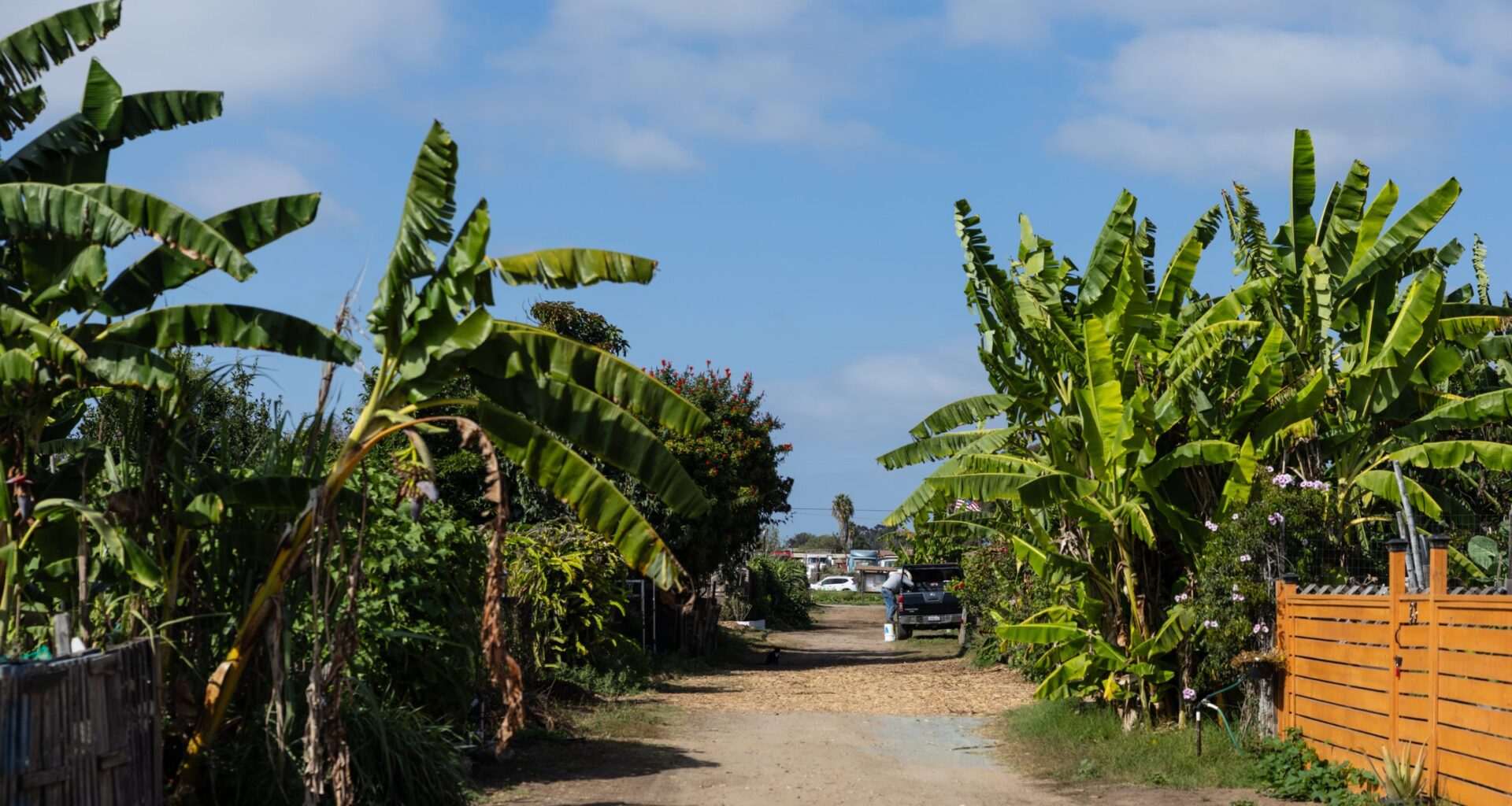It’s 20 acres you’ve probably never heard of. Until now.
The Tijuana River Valley Community Garden suddenly is all over the news. Since the start of this month, the hub of more than 200 community garden plots and small-scale farms nestled amid woodsy scrubland near the U.S.-Mexico border has been on TV, in the newspaper and all over social media.
That’s because the small government agency that managed the garden without incident for years suddenly informed gardeners two weeks ago the agency was pulling out and gardeners had 60 days to pack up and leave.
The uproar that ensued has reached the highest levels of county government.
South County Supervisor Paloma Aguirre addressed the garden closure at a recent packed town hall. She promised to do everything she could to keep the garden open and said she has urged county staff to find a solution. Today, she published a newpsper commentary depicting the gardeners’ plight as the latest episode in what she called a yearslong pattern of government neglect.
The gardeners, she wrote, “are living with the consequences of a broken system that has failed all of us for decades.”
 Bill Burns shows grapes that are growing in his plot at the Tijuana River Valley Community Garden in the Nestor neighborhood of San Diego, Monday, Oct. 6, 2025. / Zoë Meyers for Voice of San Diego
Bill Burns shows grapes that are growing in his plot at the Tijuana River Valley Community Garden in the Nestor neighborhood of San Diego, Monday, Oct. 6, 2025. / Zoë Meyers for Voice of San Diego
The garden, in other words, has become a symbol of something larger.
But of what, exactly?
Until the gardeners received those eviction notices, they told me, they weren’t feeling neglected at all. They paid a bargain rent – $324 per year for a garden plot, $1,600 for a quarter-acre farm site – and said the sewage pollution issues Aguirre referenced in her commentary actually had gotten better in recent years.
“I’m not aware of anyone having health issues at the garden,” said Bryan Rivera, whose Abriendo Camino farm grows medicinal herbs for sale on a quarter-acre at the site. “Every year they test the soil and make sure we can grow. We’ve been there a year and a half and I don’t notice anything.”
In fact, Rivera said, he was quite happy with the support he and other gardeners got from the Resource Conservation District of Greater San Diego County, the agency that recently attempted to end its management of the garden.
“The RCD was very supportive,” Rivera said. “They helped promote our events and came down every two or three months and sat down with the management team and had ideas and they had two [farming] festivals in spring and fall.”
Ann Baldridge, executive director at the conservation district, said her agency decided to pull out in part because of Aguirre’s own efforts to raise awareness about sewage pollution. Those efforts, Baldridge said, spooked district board members, who feared they faced ruinous liability if anyone sued over a health problem.
If there’s a symbolic meaning in any of this, it’s that public policy problems rarely conform to tidy narratives. What I’ve mostly encountered reporting this story is not a made-for-TV scenario of family farmers fighting back against the forces of oppression, but a round-robin of government officials blaming each other and a scramble to fix something that, until a few weeks ago, didn’t appear to be broken.
The solution that seems to be emerging is equally anticlimactic.
Cat Henning, a flower farmer in Encinitas who is one of several San Diego-area farmers working to help save the garden, said at least two non–profit farming organizations have expressed interest in working with county officials to manage the garden for an interim period.
Henning recently started a GoFundMe site to raise money to make it easier for a non–profit organization to take over garden management. Henning said the garden operates at a roughly $20,000-per-year loss. She said she hopes to raise enough to cover that gap for five years.
Henning said a government agency, such as the county of San Diego, which owns the land the garden occupies, likely will need to become the garden’s main financial backer at some point. The fundraiser has netted just $365 so far, she said, and the issue of legal liability in an area with well-publicized pollution problems remains unresolved.
A county spokesperson said officials are willing to help the garden but have not yet settled on a plan or made a financial commitment.
“The County does not have plans to change the use of the [garden’s] land or sell it,” said spokesperson Tammy Glenn in an email. “We know how important this amenity is to the community and will work with everyone involved over the next few months to support the gardeners and find options.”
For the gardeners themselves, South San Diego County’s larger struggles seem to matter less at the moment than the more immediate task of finding a way to stay on their little plot of land.
“We’re asking for the public’s support because not too many people know about this garden,” said Rivera.
In Other News
Recently appointed Imperial Beach City Councilmember Mariko Nakawatase formally took her seat on the Council Wednesday at a short swearing-in ceremony. Nakawatase, who represents Council District 3, said she hopes to promote economic development and boost her city’s reputation, which she said has been battered by the ongoing Tijuana River sewage crisis.
Also in Imperial Beach, Councilmembers on Wednesday discussed a plan to revamp the city’s 13th Street business corridor. The Council looked at work already completed on the plan and urged city staff to solicit more community input. The plan could involve improving the streetscape, adding more housing and recruiting more businesses to the area.
South County state lawmakers cleaned up in this year’s Sacramento legislative sweepstakes. Gov. Gavin Newsom recently signed into law three key bills authored by sState Sen. Steve Padilla. The bills aim to regulate AI chatbots, shield energy ratepayers from footing the bill for AI data centers and boost career technical education opportunities. Newsom earlier signed a bill authored by Assemblymember David Alvarez that aims to lower gas prices by widening the range of ethanol blends available at fuel pumps.
The San Diego Foundation last week awarded $650,000 in grants to nine organizations in the United States and Mexico working to resolve the Tijuana River sewage crisis. The grants will support research, education, habitat restoration and water quality projects.
Chula Vista Mayor John McCann’s latest weekly email to constituents is filled with even more than the usual number of emojis. And for good reason. The email highlights the city’s upcoming Trunk or Treat celebrations happening at multiple locations Oct. 17-31. What is a Trunk or Treat? Why, it’s a Halloween event at which local car enthusiasts decorate their trunks in spooky style while kids show off costumes and collect candy. It’s Halloween fun, South County-style. More information here.

